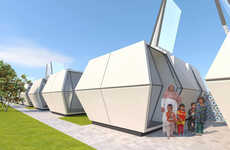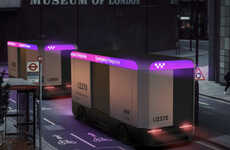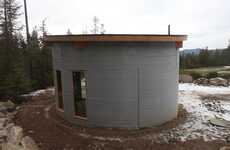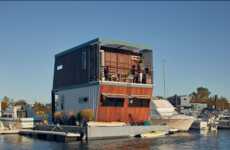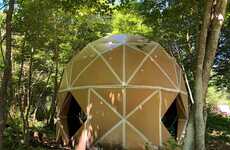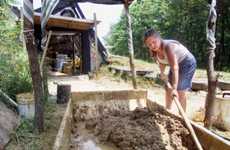
"What if New York City. . ."
Ayman — February 10, 2008 — Art & Design
References: nyc.gov
New York City sought innovative ideas for providing provisional housing for residents who may lose their homes as the result of a catastrophic coastal storm. Because of the city's high population density and the desire to resettle as many residents as possible in their former neighborhoods, a new paradigm is sought to supplement existing temporary housing programs.
The winning designs were announced on 6-February-2008. Ten winners with a prize of USD $10,000 each were selected by the jury. The winning designs included, Mobile Emergency Relief Ports (M.E.R.P.s), Threading Water, Community Provisional Residence (CPR), Container Living Apparatus (CLA), SCALE: Sustainable Contemporary Adaptable Living Environment, Rapidly Deployable inflatable Containers (RDIC) and other designs.
To aid the Competitors' understanding of the context for which they are designing, the Sponsors have illustrated the changing conditions of a hypothetical neighborhood, Prospect Shore, as it struggles through recovery after a catastrophic coastal storm hits New York City. The scenario unfolds on three parallel tracks: what happens at the scale of the city, what happens at the scale of the neighborhood, and what happens at the scale of a household.
The city scenario presents the story of the disaster from a general perspective, highlighting policy and decision making. Because a successful plan for Provisional Housing is constrained by factors beyond the physical nature of the site, Competitors should be aware of disaster response and recovery operations but not be bound by current regulations and programs.
The neighborhood scenario demonstrates the evolution of the ground conditions for which the Competitors are designing. Damage assessments, debris removal and utility restoration all play major roles, but most important is the disruption and gradual resumption of normal life for the displaced population.
The built environment of the neighborhood is a collage, drawn from parts of the city that are most vulnerable to storms while maintaining the diversity of land and building types found across New York City neighborhoods. The storm damage and recovery process in this neighborhood would be typical; therefore, a design for Provisional Housing that works for Prospect Shore could
For more information visit the "What if NY City..." site here
The winning designs were announced on 6-February-2008. Ten winners with a prize of USD $10,000 each were selected by the jury. The winning designs included, Mobile Emergency Relief Ports (M.E.R.P.s), Threading Water, Community Provisional Residence (CPR), Container Living Apparatus (CLA), SCALE: Sustainable Contemporary Adaptable Living Environment, Rapidly Deployable inflatable Containers (RDIC) and other designs.
To aid the Competitors' understanding of the context for which they are designing, the Sponsors have illustrated the changing conditions of a hypothetical neighborhood, Prospect Shore, as it struggles through recovery after a catastrophic coastal storm hits New York City. The scenario unfolds on three parallel tracks: what happens at the scale of the city, what happens at the scale of the neighborhood, and what happens at the scale of a household.
The city scenario presents the story of the disaster from a general perspective, highlighting policy and decision making. Because a successful plan for Provisional Housing is constrained by factors beyond the physical nature of the site, Competitors should be aware of disaster response and recovery operations but not be bound by current regulations and programs.
The neighborhood scenario demonstrates the evolution of the ground conditions for which the Competitors are designing. Damage assessments, debris removal and utility restoration all play major roles, but most important is the disruption and gradual resumption of normal life for the displaced population.
The built environment of the neighborhood is a collage, drawn from parts of the city that are most vulnerable to storms while maintaining the diversity of land and building types found across New York City neighborhoods. The storm damage and recovery process in this neighborhood would be typical; therefore, a design for Provisional Housing that works for Prospect Shore could
For more information visit the "What if NY City..." site here
Trend Themes
1. Provisional Housing Solutions - Innovative designs are sought to supplement existing temporary housing programs to provide provisional housing for residents who may lose their homes as the result of a catastrophic coastal storm.
2. Rapidly Deployable Containers - One winning design concept called 'Rapidly Deployable inflatable Containers (RDIC)' can be further developed into a disruptive innovative opportunity for scalable and affordable emergency housing solutions.
3. Sustainable Adaptive Living - The SCALE: Sustainable Contemporary Adaptable Living Environment design can inspire disruptive innovations for sustainable, scalable, and adaptable housing solutions for future cities that are resilient to natural disasters.
Industry Implications
1. Real Estate and Housing - Innovations in provisional housing solutions with rapid and affordable deployment can disrupt and transform the traditional real estate and housing industry.
2. Emergency Management and Response - Innovations in disaster-relief housing designs can disrupt and transform the field of emergency management and response for natural disasters.
3. Architecture and Urban Planning - Innovations in sustainable and scalable adaptive living designs can disrupt and transform the architecture and urban planning industry, reshaping the way cities and communities prepare for and respond to natural disasters.
1.7
Score
Popularity
Activity
Freshness

